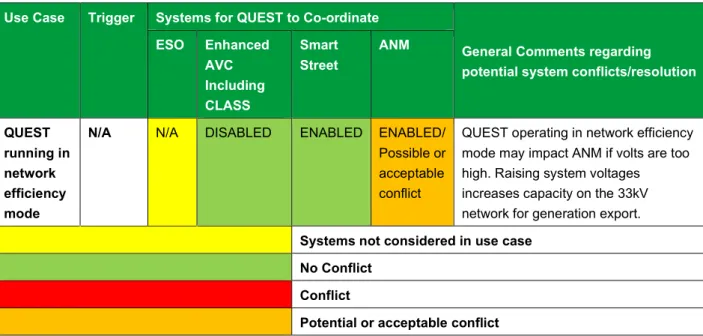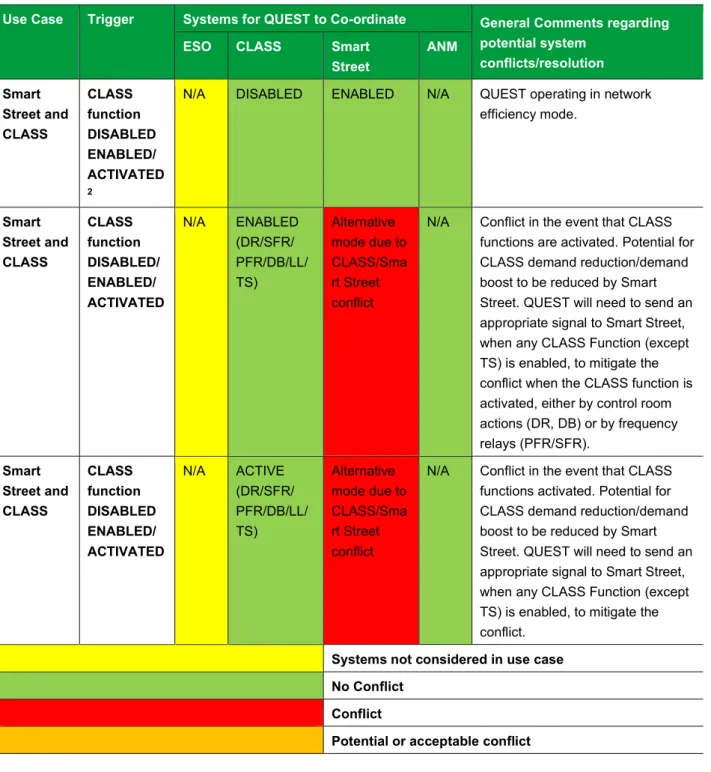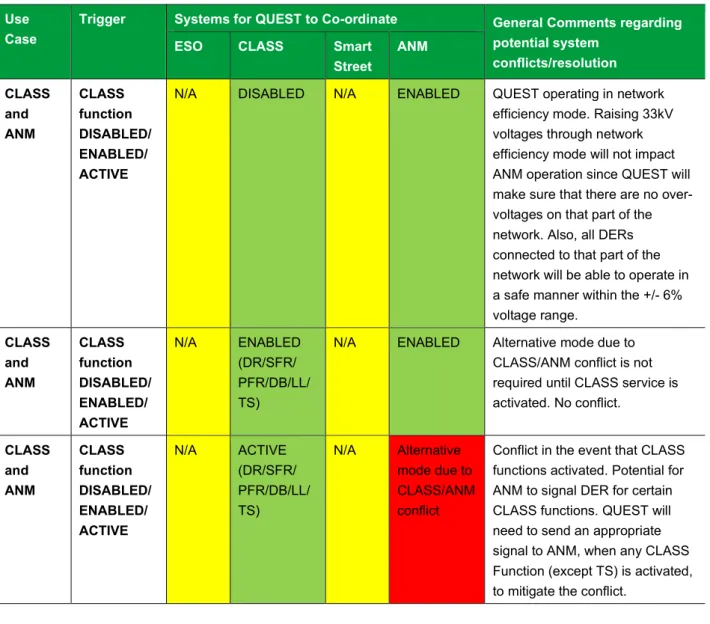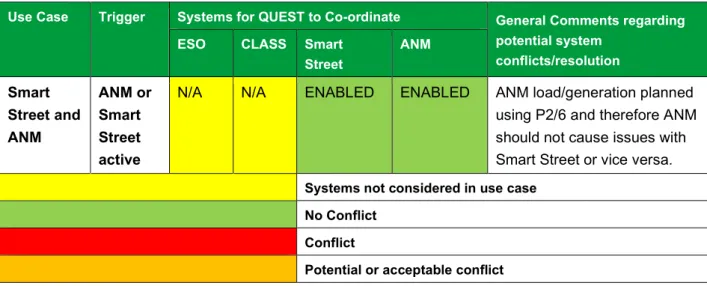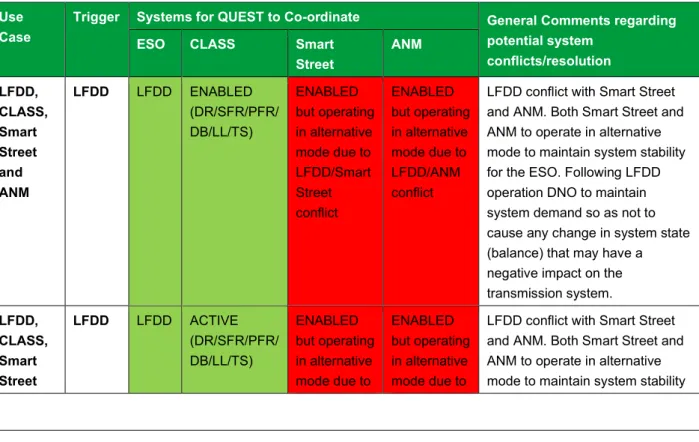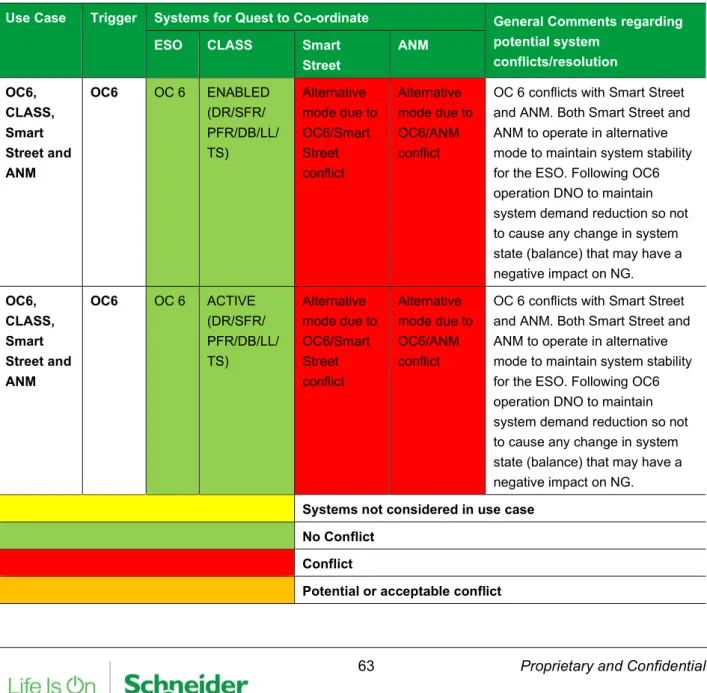INTRODUCTION
OVERVIEW
QUEST NETWORK EFFICIENCY MODE
- QUEST Use Case Matrix - Network Efficiency Mode
- Use Case 1 - Quest Network Efficiency, CLASS, ANM & Smart Street
- Options to Avoid or Mitigate Conflicts
- QUEST Voltage Optimiser Additional General Requirements
Based on the changes made to the QUEST use case matrix, the network efficiency use case has also changed. The status of ANM and Smart Street does not affect the operation of the network efficiency mode (both ANM and Smart Street can be enabled).
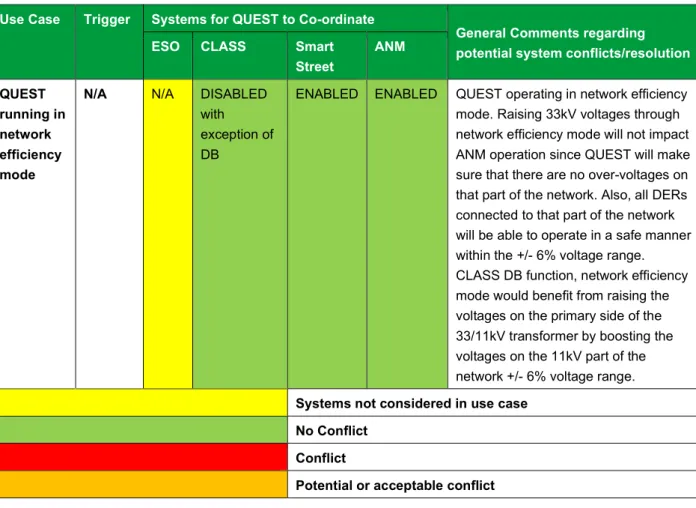
QUEST’S REACTION TO CLASS FUNCTIONS ENABLEMENT VS ACTIVATION . 15
Putting Smart Street in and releasing it from “CLASS Forecast and Optimise Mode”
- Use Case 2 - CLASS & Smart Street
- QUEST Use Case Matrix - CLASS & Smart Street
- Options to Avoid or Mitigate Conflicts between CLASS and Smart Street
- CLASS DR
- CLASS DB
- CLASS PFR/SFR
This CFOM mode of Smart Street will be activated when CLASS SFR is activated (at NMS level). Customer benefits from Smart Street CVR are reduced while CLASS DR is enabled but not active.
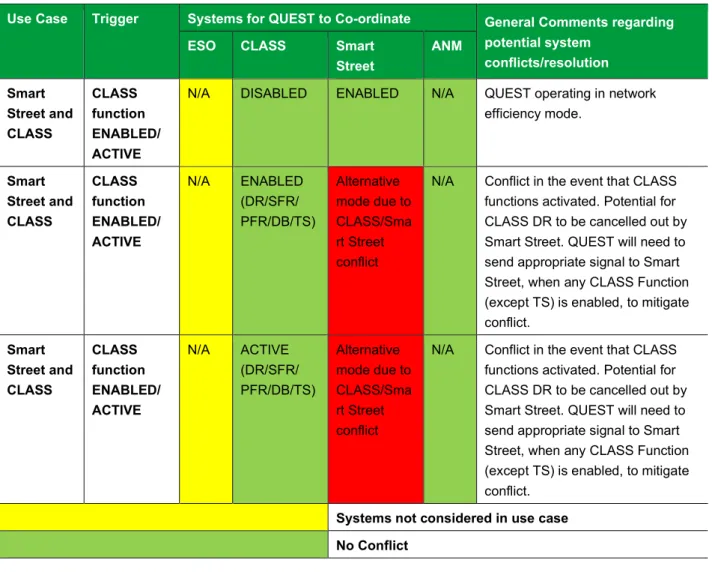
Putting ANM in and releasing it from “CLASS Forecast and Optimise Mode”
- Use Case 4 - CLASS & ANM
- QUEST Use Case Matrix - CLASS & ANM
- Options to Avoid or Mitigate Conflicts between CLASS and ANM
- CLASS DR and DB
- Cloud ANM
- CLASS PFR/SFR
35 Proprietary and Confidential QUEST Voltage Optimiser is aware of all the applications enabled on the observed part of the network. Upon completion of the CLASS service, QUEST instructs ANM to return to its original operational mode. Upon completion of the CLASS service, CLASS restores the CA moving to the post-event state.
Also, all DERs connected to this part of the grid will be able to operate safely within +/- 6%. Although it is noted that adaptive DER services could potentially be managed to support CLASS DR or DB services (reduce demand import or increase generation export for CLASS DR, increase demand import or decrease generation export for CLASS DB), this is not a function of ANM or QUEST systems and is not considered when developing QUEST functionality. The proposal is to improve the Central ANM version to be used for QUEST trial purposes by implementing the QUEST algorithm.
If during the QUEST test it is determined that this functionality is required for a central ANM operating in production, it will be implemented in the second phase of the NMS ANM project. It should be noted that the CLASS SFR and PFR are not used and are not part of the CLASS control panel.
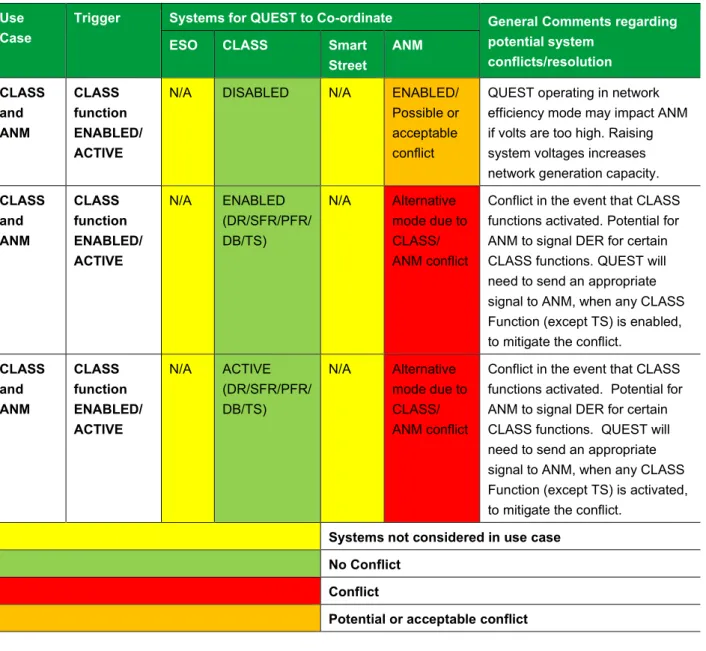
SMART STREET AND ANM COORDINATION
Use Case 3 - Smart Street & ANM
This use case describes the coordination between Smart Street and the systems that provide Flexible Connection ANM functionalities (Central ANM NMS and Decentralized ANM) and Flexible Services ANM (Central ANM NMS and Cloud ANM) provided by the QUEST Voltage Optimiser. 1 The QUEST Voltage Optimiser assumes that the level of Smart Street CVR demand reduction alone or in combination with ANM Flexible Service dispatching can reduce available network capacity. 2 The QUEST Voltage Optimiser does not intervene and both Smart Street and ANM Flexible Services continue to operate independently of each other.
2c QUEST Voltage Optimizer predicts and optimizes (based on its priority matrix) that changing ANM Flexible Service dispatch is cheaper than changing Smart Street CVR behavior. 3c QUEST Voltage Optimizer will continue to modify ANM Flexible Service dispatch until it is no longer necessary or changing Smart Street CVR behavior becomes cheaper than changing ANM Flexible Service dispatch. QUEST Voltage Optimizer records the start and end times of each intervention for each Smart Street location and correspondingly for each ANM Flexible Service intervention.
3d The QUEST Voltage Optimiser continues to adapt ANM Flexible Service dispatching and Smart Street CVR behavior to QUEST economic decisions until they are no longer needed. The QUEST Voltage Optimiser releases Smart Street CVR and Flexible Service modified behavior intervention when it is no longer needed.
Options to Avoid or Mitigate Conflicts between Smart Street and ANM
Option D in UC3) – QUEST predicts the level of restriction for each generation of Flexible Link and considers the best economic solution to implement, concluding that a combination of changing the behavior of Smart Street CVR in some substations in combination with modifications in dispatching Flexibility Services offers optimal economic solutions. This option may not be acceptable as it does not provide QUEST with the innovative new solutions expected by ENWL or the Regulator. On the other hand, this option is a valid solution if it is confirmed by ENWL that the concept of a conflict between the Smart Street CVR operation and the override of the Flexible Link generation CiDs is not actually a conflict that requires QUEST intervention.
Recording all decisions with start and stop times and quantities of each intervention action at each network constraint location. Forecasting demand and production and translating this into a forecast constraint is already a function of the central ANM. It is also a planned function of the Cloud ANM to forecast demand and production and provide these forecasts to the NMS, which will then use the NMS network model to predict constraints and send it to the Cloud ANM, which will then initiate the dispatch of Flexibility Services to address these forecasting constraints.
What QUEST requires is to use the forecast constraints and determine an economically optimized schedule for the implementation of Smart Street, Flexible Connection generation and Flexibility Services (Cloud ANM and Central ANM Flexibility Services). However, as this functionality requires complex advanced analytics, an economic optimization to allow QUEST to understand the cost of when connection agreements (cut index) are violated and predict when this may happen to change its decision, it is still an open question whether this functionality should be left to a future QUEST implementation phase.
CLASS, SMART STREET AND ANM COORDINATION
Use Case 5 - Smart Street, CLASS and ANM
Smart Street performs voltage reduction to the defined limits to provide demand reduction in the LV parts of the network. 53 Proprietary and Confidential Smart Street tap operations that respond to the new voltage may not resolve the LV violation. QUEST stipulates that Smart Street functionality must be put into a “CLASS forecast and optimization mode” that secures the network against potential problems while balancing all system goals.
Smart Street tap operations, responding to the new voltage set points, decreasing demand within their area and the wider area, reducing the impact of CLASS actions. 54 Proprietary and Confidential QUEST stipulates that the Smart Street functionality should be put into a "CLASS Prediction and Optimization Mode", protecting the network from any potential problems while balancing all system objectives. Upon completion of the CLASS service, QUEST will inform ANM and Smart Street to resume their normal mode of operation.
Smart Street tap operations responding to the new voltage cause a low voltage problem that it cannot fix. Smart Street tap operations responding to the new voltage cause a low voltage problem that it cannot fix.
ESO INSTRUCTIONS FOR EMERGENCY RESPONSE
- QUEST Use Case Matrix - LFDD Response to the ESO
- Use Case 6 - Smart Street, CLASS, ANM & LFDD
- Options to Mitigate Conflict between LFDD and Smart Street and ANM
- LFDD and Smart Street
- LFDD and ANM
- LFDD and QUEST Operating in the Network Efficiency Mode
- OC6 Mode (Manually Initiated Disconnection)
- QUEST Use Case Matrix - OC6 Response to the ESO
- Use Case 7 - Smart Street, Enhanced AVC Including CLASS, ANM & OC6
- Options to Mitigate Conflict between OC6 and Other Systems (CLASS, Smart Street
- Reactive Power Response
- Use Case 8 - Smart Street, Enhanced AVC Including CLASS, ANM & Reactive Power
QUEST partners agreed that there is no conflict between LFDD and Smart Street. Smart Street remains enabled or in CFOM mode (if previously placed in this mode for CLASS alignment). With the definition of use case 7 regarding OC6 activation, it was determined that Smart Street and ANM should be placed in a safe mode called "OC6 mode".
Both Smart Street and ANM should operate in alternate mode to maintain system stability for ESO. OC6 has been implemented as requested (demand reduction/suspended and not yet restored), CLASS remains enabled, Smart Street and ANM go into OC6 mode and “efficiency mode”. turn off QUEST. This section describes the coordination between reactive power response to ESO (absorbing reactive power to reduce voltage in the national grid), enhanced AVC, including CLASS, Smart Street and ANM.
68 Proprietary and Confidential Table 8.4 – Reactive power response, CLASS, Smart Street and ANM use case matrix. Post Conditions Reactive power response has been provided and KLAS remains enabled, Smart Street and ANM are in the operating mode applied before the reactive power response is enabled.
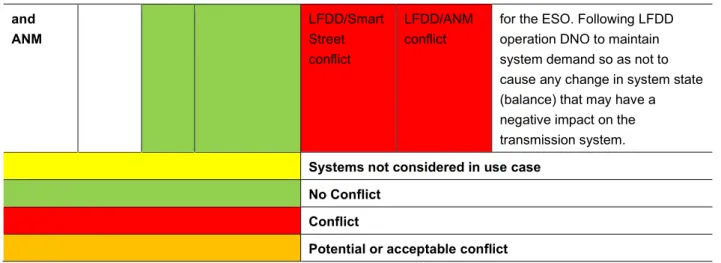
CONCLUSION
In the final discussions regarding this sub-phase 1 report, a number of important points regarding QUEST functionality and overall objectives were identified which will also need to be addressed in the detailed design of sub-phase 2. While QUEST will be piloted in one GSP-fed network area, the need for a network zone approach to QUEST conflict management needs to be explored in detailed design sub-phase 2. Detailed design sub-phase 2 should consider additional options in terms of Smart Street and CLASS DR coordination.
Sub-phase 2 of the detailed design should also consider the possibility of a Smart Street quick tap to improve QUEST. Subphase 2 of the Detailed Design should begin by reviewing the QUEST functionality from Subphase 1 of the Detailed Design against the QUEST objectives to ensure that those objectives are met. Where deemed necessary, the QUEST team should reach agreement on any changes to the plan to be covered in Sub-Phase 2 of the Detailed Plan.
Comments regarding the detailed design alignment to the QUEST objectives should be included in the final detailed design report. Detailed Design Subphase 1 considered three QUEST macro-level architecture options that could be used to resolve the detected conflicts found in the Use Cases.
APPENDICES
APPENDIX A - Interactions between CLASS DR and ANM
As a result of the dispatching of EC electricity exports to the circuit, the total demand on the 11kV circuit and the primary transformer station is reduced. ANM arranges for the ES to export additional power to reduce the flow of power demand in the 11kV circuit until it is no longer needed or until the ES runs out. As a result of the DR implementation of voltage reduction on the primary RTP, the total consumption on the 11kV circuit is further reduced.
76 Proprietary and confidential Figure 10.7 - CLASS DRF and ANM conflict: ANM exempts ES from dispatching power output As ES no longer exports power to the grid, the total demand for the 11kV supply increases. ANM keeps the ES outputting additional power to limit the power demand flow on the 11kV circuit until it is no longer required or the ES runs out. As a result of performing DR voltage reduction at the primary substation, the total demand on the 11kV circuit is additionally reduced, as shown in Figure 10.5.
78 Proprietary and Confidential Figure 10.10 - Reconciliation of DRF CLASS and ANM by QUEST: QUEST prevents ANM from reducing. 79 Proprietary and Confidential Figure 10.12 - Matching CLASS DRF and ANM by QUEST: ANM responds to reverse power flow.

APPENDIX B - Interactions between CLASS DB and ANM
As a result of curtailment of generation, the reverse power current on the 11kV circuit and the primary substation is reduced. As production is still limited, the total demand on the 11kV circuit and the primary substation is still increasing. As a result of performing CLASS voltage increase at the primary substation, the total 11kV circuit is increased further.
Since the exporting power increases when the power export of the controlled country is released, the total demand on the 11 kV circuit and the primary substation decreases. As a result of the generation limitation, the total demand on the 11 kV circuit and the primary substation has increased. Since generation is still limited, the total demand for the 11 kV circuit and primary substation is still increasing.
84 Proprietary and Confidential Figure 10.21 - DBF and ANM Class Coordination by QUEST: QUEST prevents ANM from releasing. 85 Proprietary and Confidential Figure 10.23 - DBF and ANM Class Coordination by QUEST: ANM reacts to the thermal capacity issue As a result of sending the ES electricity export, the thermal capacity issue disappears.
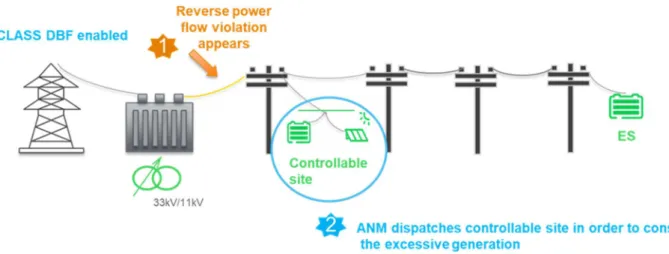
DEFINITIONS AND ABBREVIATIONS
